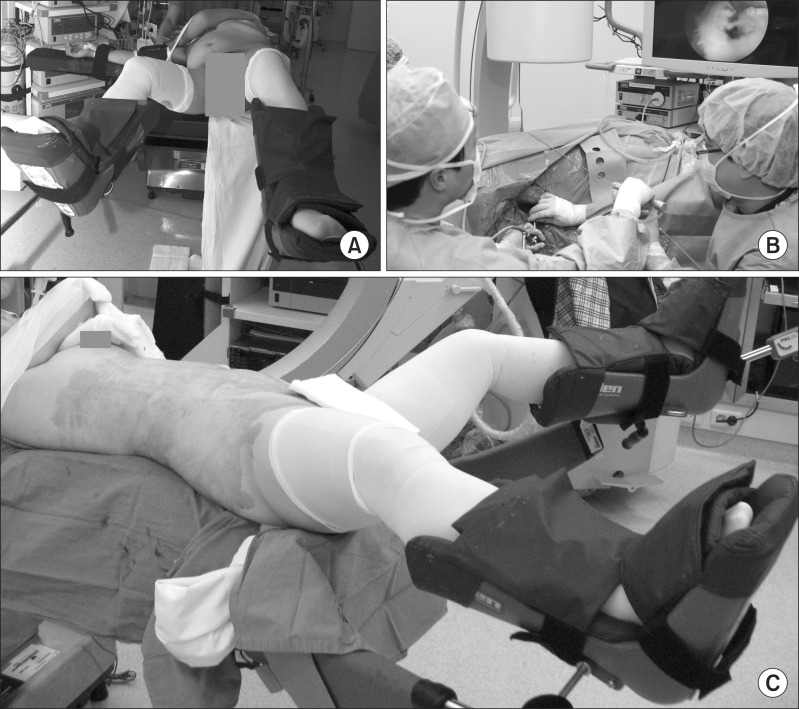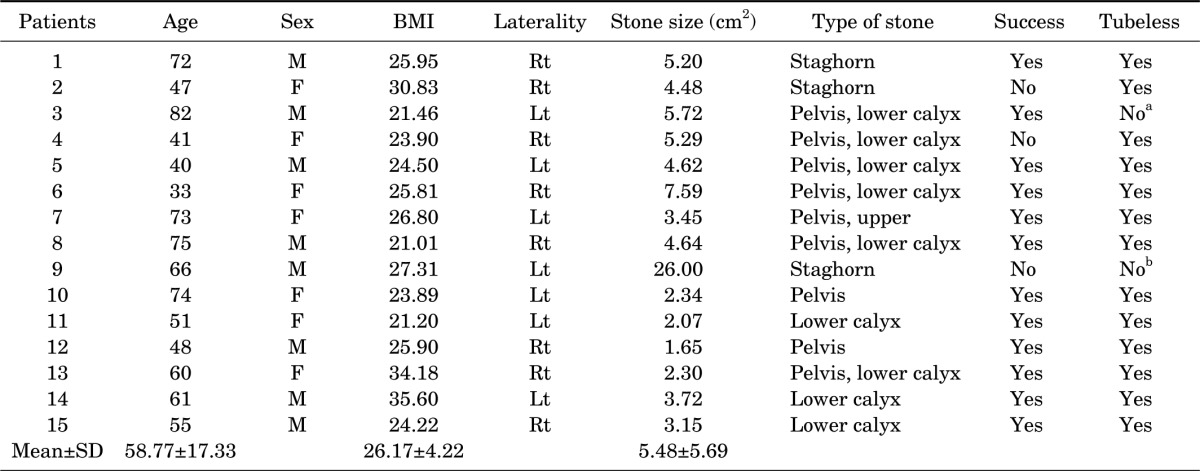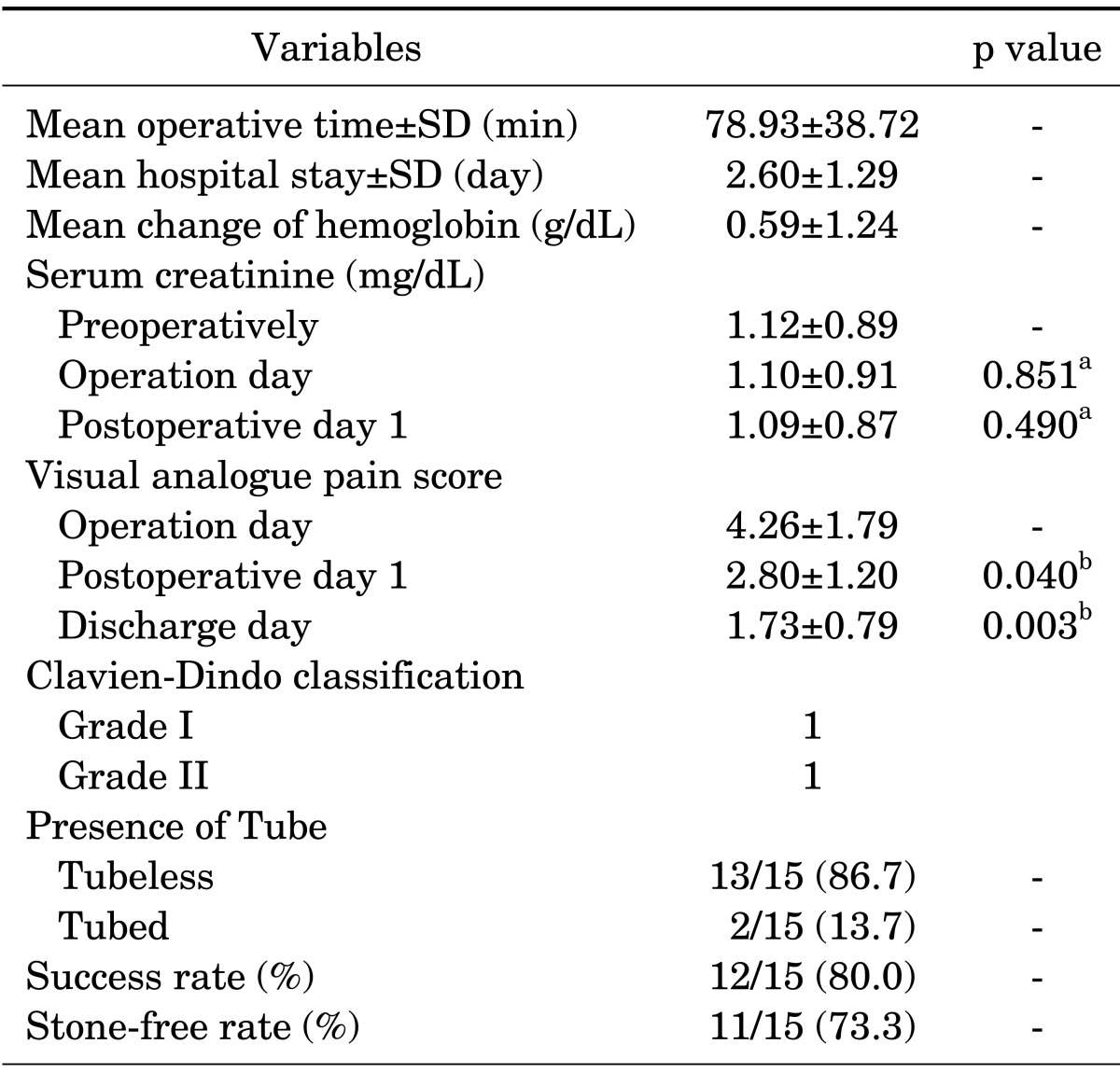1. Segura JW, Patterson DE, LeRoy AJ, May GR, Smith LH. Percutaneous lithotripsy. J Urol. 1983; 130:1051–1054. PMID:
6644881.
2. Kerbl K, Clayman RV, Chandhoke PS, Urban DA, De Leo BC, Carbone JM. Percutaneous stone removal with the patient in a flank position. J Urol. 1994; 151:686–688. PMID:
8308982.
3. Valdivia Uría JG, Valle Gerhold J, López López JA, Villarroya Rodriguez S, Ambroj Navarro C, Ramirez Fabián M, et al. Technique and complications of percutaneous nephroscopy: experience with 557 patients in the supine position. J Urol. 1998; 160:1975–1978. PMID:
9817303.
4. Kwon S, Kim HG. A comparative study between standard and tubeless percutaneous nephrolithotomy. Korean J Urol. 2007; 48:45–48.
5. Jeong WJ, Jeon HG, Yang SC, Han WK. Percutaneous nephrolithotomy in a semi-lateral position. Korean J Urol. 2009; 50:892–896.
6. Clayman RV, Bub P, Haaff E, Dresner S. Prone flexible cystoscopy: an adjunct to percutaneous stone removal. J Urol. 1987; 137:65–67. PMID:
3795367.
7. Istanbulluoglu MO, Cicek T, Ozturk B, Gonen M, Ozkardes H. Percutaneous nephrolithotomy: nephrostomy or tubeless or totally tubeless? Urology. 2010; 75:1043–1046. PMID:
19854490.
8. Paul EM, Marcovich R, Lee BR, Smith AD. Choosing the ideal nephrostomy tube. BJU Int. 2003; 92:672–677. PMID:
14616443.
9. Tiselius HG, Andersson A. Stone burden in an average Swedish population of stone formers requiring active stone removal: how can the stone size be estimated in the clinical routine? Eur Urol. 2003; 43:275–281. PMID:
12600431.
10. Park J, Hong B, Park T, Park HK. Effectiveness of noncontrast computed tomography in evaluation of residual stones after percutaneous nephrolithotomy. J Endourol. 2007; 21:684–687. PMID:
17705749.
11. Shin TS, Cho HJ, Hong SH, Lee JY, Kim SW, Hwang TK. Complications of percutaneous nephrolithotomy classified by the modified clavien grading system: a single center's experience over 16 years. Korean J Urol. 2011; 52:769–775. PMID:
22195267.
12. Dindo D, Demartines N, Clavien PA. Classification of surgical complications: a new proposal with evaluation in a cohort of 6336 patients and results of a survey. Ann Surg. 2004; 240:205–213. PMID:
15273542.
13. Rana AM, Bhojwani JP, Junejo NN, Das Bhagia S. Tubeless PCNL with patient in supine position: procedure for all seasons?--with comprehensive technique. Urology. 2008; 71:581–585. PMID:
18279935.
14. De Sio M, Autorino R, Quarto G, Calabrò F, Damiano R, Giugliano F, et al. Modified supine versus prone position in percutaneous nephrolithotomy for renal stones treatable with a single percutaneous access: a prospective randomized trial. Eur Urol. 2008; 54:196–202. PMID:
18262711.
15. Karami H, Mohammadi R, Lotfi B. A study on comparative outcomes of percutaneous nephrolithotomy in prone, supine, and flank positions. World J Urol. 2013; 31:1225–1230. PMID:
22692449.
16. Shoma AM, Eraky I, El-Kenawy MR, El-Kappany HA. Percutaneous nephrolithotomy in the supine position: technical aspects and functional outcome compared with the prone technique. Urology. 2002; 60:388–392. PMID:
12350467.
17. Hoznek A, Rode J, Ouzaid I, Faraj B, Kimuli M, de la Taille A, et al. Modified supine percutaneous nephrolithotomy for large kidney and ureteral stones: technique and results. Eur Urol. 2012; 61:164–170. PMID:
21570174.
18. Xu KW, Huang J, Guo ZH, Lin TX, Zhang CX, Liu H, et al. Percutaneous nephrolithotomy in semisupine position: a modified approach for renal calculus. Urol Res. 2011; 39:467–475. PMID:
21336573.
19. Ng MT, Sun WH, Cheng CW, Chan ES. Supine position is safe and effective for percutaneous nephrolithotomy. J Endourol. 2004; 18:469–474. PMID:
15253823.
20. Segura JW, Patterson DE, LeRoy AJ, Williams HJ Jr, Barrett DM, Benson RC Jr, et al. Percutaneous removal of kidney stones: review of 1,000 cases. J Urol. 1985; 134:1077–1081. PMID:
4057395.
21. Basiri A, Mohammadi Sichani M. Supine percutaneous nephrolithotomy, is it really effective? A systematic review of literature. Urol J. 2009; 6:73–77. PMID:
19472122.
22. Hopper KD, Sherman JL, Luethke JM, Ghaed N. The retrorenal colon in the supine and prone patient. Radiology. 1987; 162:443–446. PMID:
3797658.
23. Papatsoris A, Masood J, El-Husseiny T, Maan Z, Saunders P, Buchholz NP. Improving patient positioning to reduce complications in prone percutaneous nephrolithotomy. J Endourol. 2009; 23:831–832. PMID:
19422310.
24. Pelosi P, Croci M, Calappi E, Cerisara M, Mulazzi D, Vicardi P, et al. The prone positioning during general anesthesia minimally affects respiratory mechanics while improving functional residual capacity and increasing oxygen tension. Anesth Analg. 1995; 80:955–960. PMID:
7726438.
25. Marchant F, Recabal P, Fernández MI, Osorio F, Benavides J. Postoperative morbidity of tubeless versus conventional percutaneous nephrolithotomy: a prospective comparative study. Urol Res. 2011; 39:477–481. PMID:
21337032.
26. Bellman GC, Davidoff R, Candela J, Gerspach J, Kurtz S, Stout L. Tubeless percutaneous renal surgery. J Urol. 1997; 157:1578–1582. PMID:
9112480.
27. Sofikerim M, Demirci D, Huri E, Erşekerci E, Karacagil M. Tubeless percutaneous nephrolithotomy: safe even in supracostal access. J Endourol. 2007; 21:967–972. PMID:
17941770.
28. Shen P, Liu Y, Wang J. Nephrostomy tube-free versus nephrostomy tube for renal drainage after percutaneous nephrolithotomy: a systematic review and meta-analysis. Urol Int. 2012; 88:298–306. PMID:
22414703.
29. Zilberman DE, Lipkin ME, de la Rosette JJ, Ferrandino MN, Mamoulakis C, Laguna MP, et al. Tubeless percutaneous nephrolithotomy--the new standard of care? J Urol. 2010; 184:1261–1266. PMID:
20723920.
30. Leibovici D, Cooper A, Lindner A, Ostrowsky R, Kleinmann J, Velikanov S, et al. Ureteral stents: morbidity and impact on quality of life. Isr Med Assoc J. 2005; 7:491–494. PMID:
16106772.





 PDF
PDF ePub
ePub Citation
Citation Print
Print




 XML Download
XML Download